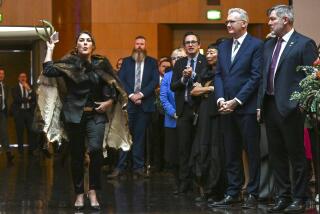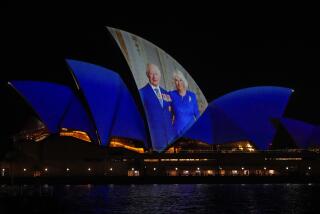Australia’s identity crisis keeps resurfacing
- Share via
In the mid-1990s, Australia’s then-Prime Minister John Howard sought to quash his nation’s “perpetual seminar on … national identity” by insisting, as he later said, that his countrymen never really “had any doubt as to what their identity was.” A little more than a decade later, however, there are plenty of signs that Howard overstated the case.
Even the casual visitor Down Under can see and hear the muted nature of the nation’s identity. Bangladeshi Australian cab drivers are likely to describe their new homeland not in terms of what it is but what it is not: “There’s no fighting here.” “It’s far away from trouble.”
And whatever is uniquely Australian is blanketed by imported Americana, from a “Today” show clone to suburbs that might as well be Orange County Down Under.
Most telling, in the titles on bookshelves and in conversations all over town, the identity crisis Howard sought to tamp down just keeps resurfacing. As one philosopher told me: If you want to define Australia, choose your narrative — British colony, aboriginal, immigrant cosmopolis. In other words, there is no one shared story, no essential Australia.
It used to be easier. From the time six separate British self-governing colonies formed the Australian commonwealth in 1901, the country’s national identity was bound up with Britain’s. Robert Menzies, Australia’s longest-serving prime minister, famously described himself as being “British to his bootstraps.”
But after World War II, with the decline and contraction of the British Empire, Australians began to see the United States as their main ally. By the early 1960s, forward-thinking business and political leaders were also reimagining an Australian future without any “imperial” protector. In 1962, the nation’s leading business newspaper, the Australian Financial Review, went so far as to suggest that geography ought to play a larger role than colonial heritage in the national conversation. Australians “may have to stop thinking about Britain as ‘home’ and start thinking urgently about getting to know very much more of our Asian neighbors’ needs.”
By the mid-1970s, the notion of an Asian future for Australia had gone mainstream and required policymakers to fully dismantle all remnants of the so-called White Australia policy, which had historically restricted nonwhite immigration to the continent. Australia had to be internally realigned to match its new geopolitical reality. It also launched a generous immigration policy.
All of this elicited broad questions about what it meant to be Australian. Some Australians wanted out of the British Commonwealth altogether. The plight of the Aborigines came to the fore. In a 1977 speech, then-Prime Minister Malcolm Fraser heralded the “end of Anglo-Saxon conformity” and suggested that the nation’s earliest English, Scottish and Irish settlers (and convicts) shouldn’t be seen as Brits but as the beginnings of what even then was a multicultural nation.
But if Howard’s assertion is any indicator, Australians wearied of diversity’s challenges. By 2005, six of the 10 most common countries of origin for Australian immigrants were Asian. The backlash emerged. It surfaced in debates over refugee policy and “illegal” Asian “boat people.”
Now there is talk about the need for integration. “But integration into what?” asks Australian scholar James Curran, the coauthor, with Stuart Ward, of “The Unknown Nation: Australia After Empire.”
So far that confusion over identity hasn’t retarded Australia’s general progress, but Curran believes that to move forward, Australians must enroll again in that seminar on identity — and this time, pass the course. Demographics continue to recast the country, its Asianness becomes more pronounced, and if a national story can’t be written to embrace that, Australia will falter.
“We have no guiding philosophy,” he argues. “There’s nothing at the moment that allows us to define ourselves and our future.”
The answer, it seems, is to engage (or reengage) in the boisterous, even confrontational identity politics that is hackneyed in the U.S. Finally, Australia must forge consensus out of difference.
If there’s one lesson Australia’s protracted identity crisis can teach the world, it’s that you can run but you can’t hide.
grodriguez@latimescolumnists.com
More to Read
Sign up for Essential California
The most important California stories and recommendations in your inbox every morning.
You may occasionally receive promotional content from the Los Angeles Times.












